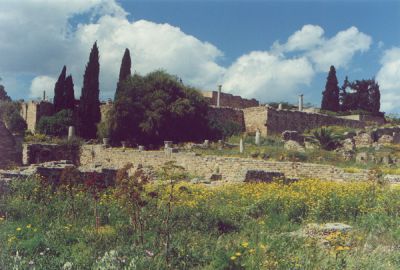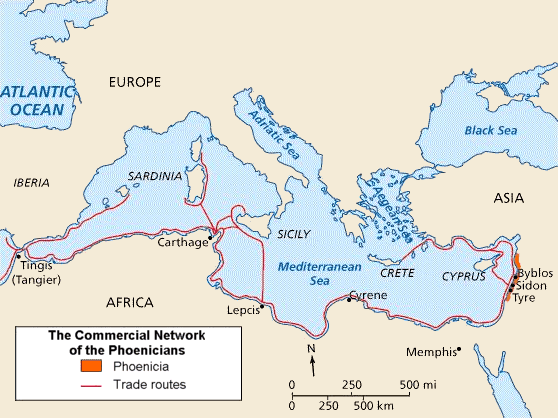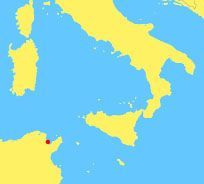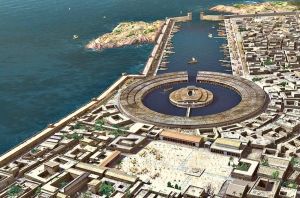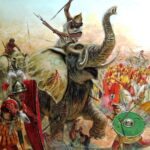Chapters
According to Appian of Alexandria, Carthage was founded in 814 BCE1 According to some legends, it was founded by the Phoenicians, led by Princess Elsha-Dido. She fled from Tire after her brother, Pygmalion, murdered her husband, Acherbas. Dido learned about the crime during a dream and decided to go on a journey with people who wanted to escape Pygmalion. They took with them many treasures. Through Cyprus, they made their way to northern Africa, where they met the Libyans. The Phoenicians asked the hosts to give them as much land as the skin of an ox would cover. Such a request seemed ridiculous to the Libyans, and without thinking about it, they agreed to this arrangement. At that time, Dido ordered the skin of an ox to create one, very thin thong and surround it with the largest possible area. According to Appian – this place was called Byrsa (in Phoenician – castle, in Greek – skin). A mighty city grew around the settlement over time.
Some Greek authors, in turn, claimed that Carthage was founded by Zorus and Carchedon. These names come from the Phoenician name of Tire and the Greek name of Carthage. The capital of Carthage, Kart Hadaszt, or New City, was probably founded in the middle of the 8th century.
Phoenicia
The routes linking Asia with Egypt ran through Syria. In the third millennium in Syria there were cities inhabited by people of Semitic origin. These cities include Sidon, Zur, Gublah, Zarephath, and Ugarit. The Phoenicians, or as they referred to themselves from the main city – the Sidonians, dealt primarily with trade and crafts. The location, limited by the proximity of the mountains of Lebanon, which sometimes descended to the sea, did not contribute to the supply of agricultural products. However, it was rich in raw materials sought especially in Egypt, cedar wood and metal ores. In the third millennium, the first Phoenician cities were founded. They were headed by kings. Initially, however, the Phoenicians did not play a major role.
In the 2nd millennium, Phenicia became a supply base for the Egyptian army. The Phoenician cities were at that time exposed to Semitic Amorite raids. The appearance of the so-called of the “sea” peoples caused the destruction of the city of Ugarit, which was not rebuilt afterwards. At that time, other Phoenician cities were also destroyed, but, due to the fact that they were located on the main trade routes, they were rebuilt. However, the development of the Phoenician cities was hampered by their neighbors – the Philistines, whose trade and privateering caused great damage to the Phoenicians. The Phoenicians are the creators of the phonetic alphabet, i.e. a system in which only simple sounds of human speech – vowels – were marked with writing signs. Such an alphabet consisted of 22 characters. Initially, the Phoenicians used cuneiform. They tried to simplify it. The invention of papyrus and the introduction of it instead of clay tablets forced the invention of a different alphabetic system, adapting it to the writing material. After Israel’s victory over the Philistines in the time of David, there was a great expansion of the Phoenician cities. The expansion developed in several directions. Contact between the Phoenicians and Israel was of great importance. In Israel, the Phoenicians found markets for their crafts in exchange for food products. Weaving developed, purple fabrics from Tire were known, liquid obtained from sea shells was used for dyeing. Bronze, glass and wood products were known and appreciated. Trade revived. It covered an increasing area of the Mediterranean Sea. The wealth flowing into Phoenicia was concentrated in the hands of the aristocracy. It abolished the monarchy. Among other social strata – there was a bad position of skilled craftsmen. Much worse was the situation of small farmers who suffered the greatest losses during the invasions of enemies and left their farms for shelter in the cities. The situation was aggravated by the growing number of slaves, so the possibility of finding work for the free poor was limited. This led to conflicts. This was the main cause of Phoenician colonization, which was directed especially at the coast of the western Mediterranean. Cyprus, which is closest to Phoenicia, was colonized by both Phenicia and Greece. There were raw materials in Cyprus, especially wood and copper. The Phoenicians founded the city of Kition here. Phoenicia directed its colonization effort primarily to the west, where there were untapped raw material resources. The Iberian Peninsula became an important area of Phoenician colonization. Metal ores, especially silver, were found there. Of particular importance was the colony of Gades, founded around 1010 BC. The next colonization area was northern Africa.
Initially, Utica played the main role, then Carthage, founded around 800 BCE, came to the fore. The coast of North Africa up to the Strait of Gibraltar was covered with a network of trading posts. Strong positions were taken by the Phoenicians in Sicily, and smaller settlements were established in Sardinia, Corsica and the Balearic Islands. The Phoenicians used their economic and political advantage. Most often, on the basis of an agreement with the chiefs of African or Spanish tribes, they occupied small plots of land. They dealt mainly with trade, successfully exchanging crafts for raw materials. Here, too, wealth accumulated in the hands of the merchant aristocracy. The colonies initially maintained close ties with their mother cities. Then they became independent, running their own politics. It reached its greatest importance in the 6th century BCE in Carthage.
Initially, Carthage was the trading base of Tire in the western Mediterranean. It was a port where Tyrian merchants could dock on their way to Spain and Italy. At the same time, it was an intermediary point in trade with African peoples. The change took place only with the fall of Tire in the 6th century BCE when Carthage could start building its empire.
The demographic explosion in Nowe Miasto has forced its inhabitants to expand their land. The most northerly areas in today’s Tunisia, Cape Bon, were conquered, and then gradually subjugated further lands of northern Africa. Carthage began to take control of the Phoenician cities while establishing colonies itself. In 654 BCE Ibiza in the Balearic Islands was colonized.
Numerous plantations were established in the valley of the Bagradas River, which provided the city with food. The cultivation of hitherto unknown olives and vines was developed, and cattle and horses were bred on a large scale.
Rise of Carthaginian power
Carthage first established its power at sea, taking advantage of the weakening of another Phoenician city of Tyre caused by the rise of the great eastern monarchies (Assyrian, Chaldean and Persian) and Greek expansion in the western Mediterranean in the 6th century BC, and then on the African coast.
Around 550 BCE Carthaginian commander Malchus, confirmed the power of Carthage, fighting both against the Libyan peoples and in Sicily and Sardinia. Suspected of tyrannical tendencies, he was subsequently overthrown. His successor Magon continued the policy of expansion, taking over Cádiz and Málaga, which gave Carthage control over the southern part of the Iberian Peninsula and stopped Greek expansion in this area. While successive expeditions managed to cross the Strait of Gibraltar and establish trading ports on the Atlantic coast of Morocco, portions of the coasts of Sicily and Sardinia were captured, and dominion in Africa gained strength thanks to the capture of the remaining Phoenician colonies. The colonization of Sicily began around the middle of the 7th century BCE, with the Carthaginians managing to stop Greek expansion on the west coast. Sicily seemed to be completely under Greek rule by now, but the Carthaginians, concentrated on a small part of the west coast, did not miss the opportunity to attack Greek colonies to prevent their multiplication.
Thus, they managed to stop the expeditions of the Greeks from Cnidus, who twice tried to establish a new colony in the vicinity of Lilibeum, near the fortified Phoenician city on the island of Motya (circa 580 BCE), and the expedition of the Spartan leader Dorieus, who, having arrived in Sicily with a group of companions to colonize the west coast, was defeated by the Carthaginians allied with the inhabitants of Sagesta around 510 BCE. Having allied with the Etruscans, the Carthaginians declared war on the Phocaeans, who, despite winning the naval battle near Alalia (Corsica), had to move away from the island. The Etruscans occupied Corsica and the coasts of Lazio, and the Carthaginians occupied Sardinia, western Sicily and Iberia. It was in the west of Sicily that the first province of Carthage, called in Greek eparchy, was founded. There were many battles on the island, mainly with the Greeks on the eastern part of the island. Malta was also captured at the same time. The rapid expansion of the New City was stopped thanks to the success of the tyrant of Syracuse, Gelon, who in 480 BCE he inflicted a severe defeat on the Carthaginians at Himera.
During this period, an ancient pact was concluded between Rome and Carthage on the delimitation of spheres of influence – according to Polybius it happened in the first year of the Roman Republic, i.e. 509 years BCE.
In his Histories, Polybius quotes the text of this treatise. The pact was to last 100 years. The Carthaginians during the war with Pyrrhus, the king of Epirus (3rd century BCE) supported the Romans with their fleet. For this reason, the Romans later had trouble granting in 264 BCE a positive response from the Mamertines, whose call for help against Carthage became the beginning of the First Punic War. This is how the Carthaginian-Roman treaty of 509 BCE describes Polybius:
So the first treaty between under Lucius Junius Brutus and the Romans and the Carthaginians of Marcus Horatius, the first consuls appointed after the overthrow of the kingdom, who also dedicated the temple of Jupiter Capitoline – twenty-eight years before Xerxes crossed over to Greece. We have translated it as accurately as possible; for the present language of the Romans also differs from the ancient to such an extent that even the most skilful can explain this and that only after careful study. This is the treaty: “The friendship between the Romans and the allies of the Romans and the Carthaginians and the allies of the Cairothaginians is to be based on the following conditions. The Romans and the Roman allies dare not sail beyond Fair Cape, unless compelled to do so by a storm or by their enemies. But if a man is driven there by force, he must not buy or take anything except what is necessary to repair the ship or to make sacrifices. he is to depart in five days, and those who come to trade in a foreign country are not allowed to do anything there, except in the presence of a herald or scribe, and what is sold with them must be guaranteed by the state to the seller, if the sale takes place in Libya or Sardinia. um, Laurentum, Circei, Terracina, or any people of the Latins, how many are subject to Rome. But if some are not subject, they are to stay away from their cities; but if they seize any, they are to return it intact to the Romans. Let them not build a fortress in Latium. If they enter the country as enemies, they are not allowed to spend the night in the country. […] It follows from this arrangement that they speak of Sardinia and Libya as their own countries; but in Sicily they make a marked difference by considering only that part of the island which is subject to the rule of the Carthaginians. Similarly, the Romans include only the Latin area in the system, and do not mention the rest of Italy, because it was not in their power2.
– Polybius, Histories, III.22-23
In 310 B.C.E. the ruler of Syracuse, Agathocles, having defeated Carthage in Sicily, crossed to Africa, which he largely devastated. Eventually, however, the ruler gave up the Carthaginian territories.
In 409 BCE Carthage renewed its attempt to conquer all of Sicily. Gradually, it subjugated further areas, fighting not only with the indigenous Sicilians but also with the determined resistance of Greek cities, led by Syracuse. At the same time, cultural contacts with Greece intensified, especially strong ties connected the city with Egypt by the Ptolemies. In 348 BCE a treaty with Rome was re-concluded, but less than a hundred years later, the territorial expansion of both countries was to lead to their direct meeting in Sicily and the outbreak of a series of dramatic wars.
The Carthaginian army, constantly fighting in Sicily, suffered in 342 BCE a heavy defeat at the Krimissos River to the Sicilian Greeks. The situation forced Carthage to enlist foreign mercenary armed men on a larger scale. Hence the statements repeated by the Romans and Greeks about “non-warlike Carthaginian merchants”, who base their state on trade and send purchased mercenaries to fight. However, this is an exaggeration, because many times the Carthaginians in the past and later joined the army, which was of a civic nature. Only the lack of men capable of fighting forced the authorities to recruit foreigners to the army.
Wars with Rome
The expansion of Carthage’s possessions in Sicily led its soldiers in 264 BCE. at the gates of Messina, a city in north-eastern Sicily occupied by the Campanian mercenaries of the Mamertines. The robbers asked for help from Rome, which had subjugated Apulia and Mesapia in southern Italy two years earlier. The crossing by the Roman legions led by Appius Claudius Caudex (grandson of the famous Appius Claudius Caecus) of the Strait of Messina marked the beginning of the conflict.
As a result of the Roman-Carthaginian Wars, called Punic Wars Carthage fell and Rome took over the Mediterranean. The Roman Senate ordered the razing of its greatest rival in the western Mediterranean in 146 BCE. The land on which the proud Phoenician city stood was sprinkled with salt so that nothing would ever grow on it again.
However, several decades later, from 122 B.C.E. there was a Roman colony in place of Carthage Colonia Iunonia, and Caesar in 44 BCE restored its old name Karthago. During the imperial era, the city flourished as the center of the Senate province Africa Proconsularis, which was the granary of Rome.
At its end, it became the center of Christianity spreading strongly in North Africa. In Carthage lived St. Cyprian, and important synods for the Church, the so-called Synods in Carthage.
In 439 CE Carthage was captured by the Vandals, who had arrived in North Africa ten years earlier, and made it their capital. Thus, the region was permanently separated from Rome.
Policy
Like the Romans, the Carthaginians had a mixed government (politeia):
- Executive power, as in Rome, was exercised by two elected officials, called suffetes, or judges (shofetim). They presided over the deliberations of the Council of Elders, called the people’s assemblies, and held the courts, but they did not lead the army into battle.
- Legislative power was vested in the Council of Elders, which conducted the actual policy of the state. The council consisted of 300 nobles who exercised their dignity for life. They made up their own composition. It was this body that received legations, decided on war and peace, formed the army and made decisions on all the most important matters for the state. Current affairs were managed by the so-called Holy Council, with 300 representatives.
- The judiciary was vested in the Tribunal of the Hundred (sometimes the Hundred and Four). Its members were elected from among the representatives of the Council of Elders. The chiefs who returned from the campaign and the officials who reported had to appear before the Tribunal. It often happened that a commander who suffered a defeat was sentenced to death, which, however, was later liberalized.
- People’s Assembly, officially making the final decisions on important matters for the country, such as the declaration of war, did not really matter much.
Religion
Religion played an important role in the life of the Carthaginians. The Carthaginians actually continued the polytheistic beliefs of the Phoenicians of the Levant region, which they modified and adapted to their conditions. The principal deities included: Melkarta, Baal Hammon and Tanit. There was also the famous dark molk ritual of sacrificing little boys of good families to Baal. It is said that Hannibal almost died in this ritual as a child. This ritual is mentioned by many ancient historians, e.g. Plutarch Tertullian, Philo of Alexandria, Diodorus Siculus and Paul Orosius. However, we have no accounts in Livy and Polybius.
Carthaginian army
In our minds, the Carthaginians have always been shrewd merchants, so obsessed with profit that they had only mercenaries in their army. We owe this mainly to Roman and Greek historians. For example, Polybius writes:
[…] The Carthaginians have a better navy and are better prepared for it, because […] they are the most sea-traders of all men; but in the conduct of war on land the Romans are much better trained than the Carthaginians … [who] have no regard for foot troops, and little care for cavalry. The reason lies in the fact that they use foreign and mercenary armies, and the Romans only domestic and civic ones. […] Also, customs and devices conducive to getting rich are better among the Romans than among the Carthaginians. For those than it is not considered ignominious, which is connected with profit, and for those [Romans] there is nothing more uglier than to be bribed and get rich in a wicked way.
– Polybius, Histories, VI.52
Meanwhile, Plato mentions Carthaginians among the warlike nations, along with Thracians, Iberians, Persians and Scythians. Researchers, after examining the Carthaginian mint stamps, came to the conclusion that during one year of the war, about 280,000 drachmas were minted, which could be enough to pay at most 2,800 mercenaries for 200 days and with low pay. Thus, stories of 100,000 or 50,000 mercenaries in the Carthaginian army can be considered fairy tales. According to Aristotle, among the Carthaginians, it was customary for citizen soldiers to wear rings to symbolize the number of expeditions in which they took part.
For centuries, Carthaginian citizens served in the military. They were, as in most ancient states divided into age classes. In addition, every adult male kept a spear or sword in his home. This is also evidenced by the fact that in 378 BCE at the news of the enemy’s incursion into the city, all the men rushed into the streets with their weapons. From the second half of the 4th century BCE Punic aristocrats formed the so-called Holy Host, a select infantry unit fighting in hoplite armament with white shields, numbering about 2500-3000 people. Most likely, all young aristocrats underwent military training there.
When it comes to cavalry, in the early period, the Carthaginians, until the 3rd century BCE, like every Middle Eastern people, used chariots with scythes covered with thick sheet metal. We hear about them during the fights with the tyrant of Syracuse Agathocles in 310 BCE, where the descendants of Dido reportedly had as many as 2,000 of them. Chariots proved themselves mainly during fights with the Libyans. Over time, as the main Carthaginian warfare moved to mountainous Sicily, its importance diminished. In the times of the Barkids, the Punic army had a light cavalry fielded by the Numidian caids, e.g. Naravasa, Syfax, and Masinissa.
The core of the Carthaginian infantry constituted native citizens as well as subject Libyans. They fought in line with Hoplite-type weapons: helmet, shield, metal or linen armor, spear, sword or saber. When it comes to mercenaries, initially light-armed troops (javelinmen, slingers) were recruited, i.e. those that the Carthaginians themselves could not form. After heavy losses at the Battle of Krimissos, Hellenic hoplites began to be enlisted to recreate the line infantry.
In the 3rd century BCE, elephants took the place of chariots. They were placed in front of the Punic phalanx in order to break the enemy formation with their strike. The first elephants were probably obtained by the Carthaginians from India. Over time, they began to capture and train the forest elephants that lived north of the Sahara in ancient times. This now-extinct species is much smaller than the African elephant and also its Indian cousin. The largest specimens reach only 2.4 meters, so it can be assumed that they did not carry turrets with warriors. Before the battle, they were donned with armor, spiked breastplates, and fang-lengthening blades to strike fear into their enemies. During the battle, each elephant was accompanied by a unit of about 50 light-armed men, whose task was to protect the animal against attacks by enemy soldiers in their sensitive places, e.g. trunks. Elephants, as we know, are timid animals, and when they go berserk in battle, they trample the enemy’s soldiers as well as their own. However, elephants helped the Carthaginians defeat rebel mercenaries and conquer the Iberian tribes. After the Second Punic War, the Romans forbade the keeping of war elephants by the Romans under a peace treaty.
Historical studies often contain information that elephants were used e.g. by the Carthaginians belonged to a subspecies of forest elephants living in the forests of what is now Central Africa. However, in zoological studies there is an opinion that these elephants constituted a separate subspecies, no longer present today. The most important argument in support of this thesis seems to be the difference between the environment in which elephants in North Africa lived and the one in which forest elephants live today (to which they are adapted). Moreover, both these zones are separated (and have been) by the Sahara barrier3.

